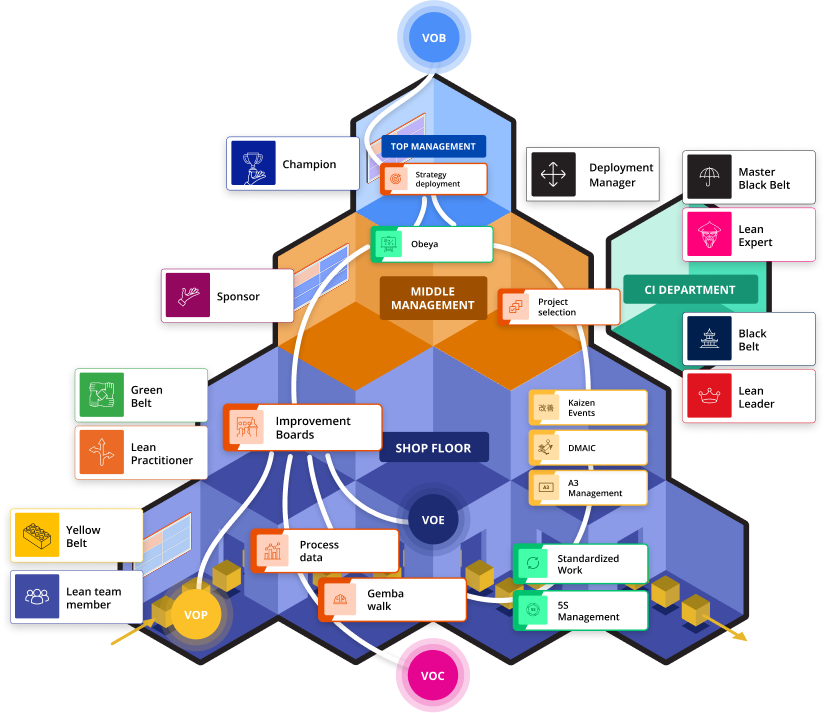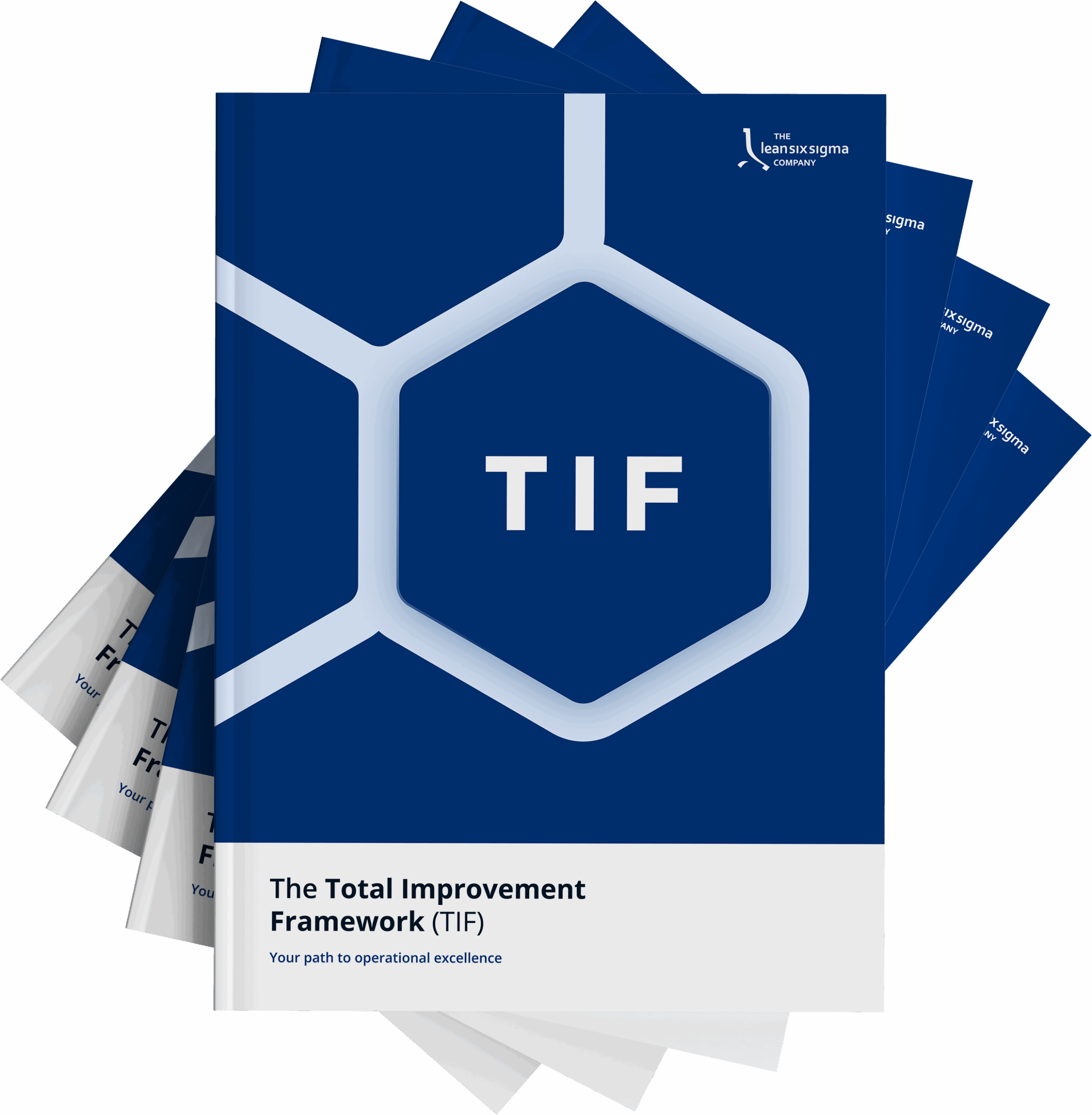
Lean Six Sigma Deployment for Sustainable Improvement
Learn all the benefits of our deployment services
- Proprietary systems approach to deploying Continuous Improvement
- Successfully proven at many organisations of any size and industry
- Easy-to-implement via a tailored phased roadmap
- Addresses past deployment failures
- Delivers results unlike any other approach

Benefits
Why deploy Lean Six Sigma?
Many organisations begin their Lean Six Sigma journey with training or stand-alone efforts. Kaizen events that resolve acute issues, 5S initiatives that bring order to the workplace, DMAIC projects that address complex and recurring problems, the list goes on. But without a structured approach, these initiatives can lose momentum or remain disconnected from broader business goals.
Lean Six Sigma delivers its full value only when it becomes part of how the organisation works. When continuous improvement is embedded in the culture, aligned with strategy, and supported by clear roles and routines, it drives lasting change. This is the purpose of deployment.
Deployment Benefits
A structured Lean Six Sigma deployment delivers far more than the results of individual projects. It brings the combined advantages of Lean Six Sigma itself, the strength of a proven deployment approach, and the expertise of a trusted partner to guide it. This means higher quality and speed, measurable financial returns, and better customer experiences through more reliable and responsive processes. It also means an organisation-wide structure that aligns improvement initiatives with strategy, connects teams and departments, and sustains progress through clear roles and routines.
These results are only achieved when all three dimensions are addressed together. The methodology provides the tools and principles. The deployment approach ensures alignment and sustainability. We bring the experience and capability to make it work in your unique context. This is exactly what our Total Improvement Framework delivers, and it is the first step in creating a Continuous Improvement Driven Organisation where improvement becomes part of everyday business.
Benefits of Lean Six Sigma
Benefits of TLSSC
Benefits of TIF
TIF
The Foundation for Deployment
The Total Improvement Framework is our proprietary approach to embedding continuous improvement across all levels of an organisation. Grounded in Lean Six Sigma principles, it provides a scalable structure for building capability, aligning efforts, and establishing routines that keep improvement active and sustained.

Structure and Adaptability
TIF combines structure with adaptability. It aligns with your organisation’s strategy, culture and maturity level while ensuring that improvement is integrated, repeatable, and focused on measurable results. By embedding defined roles and routines, supported by leadership involvement and continuous feedback, TIF transforms Lean Six Sigma from a project-based tool into a shared and lasting way of working.
The Four Voices
At the core of TIF are the Four Voices: the Voice of the Customer, the Voice of the Business, the Voice of the Process, and the Voice of the Employee. These guide priorities, define value, and ensure that improvement reflects both strategic goals and operational realities.
CIDO
The outcome is a Continuous Improvement Driven Organisation. In a CIDO, every role contributes to improvement, every process follows a structured rhythm, and progress is sustained over time. This is not a short-term programme but a fundamental shift in how the organisation thinks, operates, and grows. Continuous improvement becomes part of everyday business.
Where to start
Roadmaps and Scaling Options
Tailored to your needs
Every organisation is different, so every deployment is built around your organisation’s specific needs. While the Total Improvement Framework provides structure, your roadmap is shaped to fit your culture, goals, and CI maturity. Whether you are launching Lean Six Sigma for the first time or scaling beyond an earlier programme, we work with you to move forward with purpose. We start from a proven framework, but every deployment is fully tailored.

Two ways to get started, one destination
Organisations typically begin in one of two ways:
• Top-down, with leadership commitment and strategic alignment
• Bottom-up, through a pilot that delivers local success and creates momentum
Both approaches are equally valid, as both lead to the same objective: becoming a fully autonomous Continuous Improvement Driven Organisation. Which works best for your organisation depends entirely on your needs, situation, and current level of CI maturity. Whichever approach you take, your roadmap will usually follow four phases of deployment, starting with a pilot and ending with a fully realised CIDO that can operate independently.

The four phases of deployment
Phase 1
Pilot
Start in one or a few business units. Align on deployment principles, prove value, and generate early engagement.
Phase 2
Roll-out
Scale the deployment to additional areas. Build internal capability, expand leadership visibility, and maintain quality.
Phase 3
Embedding
Formalise roles, leadership structures, and governance routines. Improvement becomes how the organisation operates.
Phase 4
Autonomous Operation
Your organisation is now a fully realised Continuous Improvement Driven Organisation. You manage training, certification, governance, and improvement independently. We remain available as a partner when needed, but our aim is that you do not rely on us for day-to-day operations. Success is measured by your ability to sustain and grow improvement without our direct involvement.
Start small.
Grow at your pace.
Deployment according to the Total Improvement Framework is scalable. There is no need to start with a detailed multi-year rollout plan. You can begin with a pilot in one business unit and already see benefits. Once the foundation is there, we work with you to scale at the right speed and scope for your organisation.
Want to explore what your roadmap looks like?
Curious what your roadmap could look like?
Download the brochure to see how TIF works in detail.

Prefer a conversation?
Schedule a call with us!
